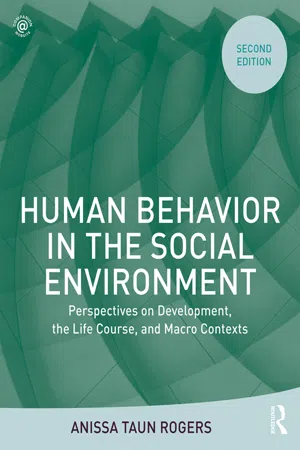
Human Behavior in the Social Environment
Perspectives on Development, the Life Course, and Macro Contexts
Anissa Rogers
- 704 Seiten
- English
- ePUB (handyfreundlich)
- Über iOS und Android verfügbar
Human Behavior in the Social Environment
Perspectives on Development, the Life Course, and Macro Contexts
Anissa Rogers
Über dieses Buch
In this new aggregated edition of Anissa Taun Roger's Human Behavior in the Social Environment, readers will find a comprehensive overview of the issues related to human behavior and the social environment. Chapters are organized to first present foundational theoretical perspectives on the human condition, and then provide information on the basic facets of human development, encouraging students to use conceptual lens to inform their practice with individuals at different stages of life. The four final chapters cover theoretical frameworks and approaches to four areas of macro concern: spirituality, families and groups, organizations, and communities. Through this section, students will understand how contemporary theories and approaches build from foundational perspectives, and how they in turn can be used to inform their work with clients.
In this edition and updated companion website, readers will also find:
-
- Particular emphasis on the ways in which poverty, diversity, and strengths affect human development and behavior
-
- The opportunity to see how the concepts fit into social work practice using chapter opening case examples that are referred to throughout the chapter.
-
- Interactive case studies at www.routledgesw.com/cases: Six easy-to-access fictional cases with dynamic characters and situations that students can easily reach from any computer and that provide a "learning by doing" format unavailable with any other text. Your students will have an advantage unlike any other they will experience in their social work training.
-
- A full library of instructor-only resources at www.routledgesw.com/hbse that provide full-text readings that connect to the concepts presented in each of the chapters; a complete bank of objective-based and essay-type test items, all linked to current CSWE EPAS (Council on Social Work Education Educational Policy and Accreditation Standards); PowerPoint presentations to help students master key concepts; annotated links to a treasure trove of social work assets on the Internet; and a forum inviting all instructors using books in the series to communicate with each other and share ideas to improve teaching and learning.
Häufig gestellte Fragen
Information
CHAPTER 1
Human Behavior and the Social Work Profession
DEFINING “HUMAN BEHAVIOR IN THE SOCIAL ENVIRONMENT”

UNDERSTANDING HOW KNOWLEDGE AND THEORY INFORM SOCIAL WORK
- A physician might be concerned only with identifying and alleviating Janice’s physical symptoms. Interventions may center solely on restoring Janice to physical health or, at least, removing evidence of disease.
- A psychologist might attend only to the individualistic or psychological aspects of Janice’s case. These might include her symptoms of PTSD, her potential for developing depression or other mental illness, her emotional and cognitive development, her issues of self-esteem and self-efficacy, and her ability to adjust to civilian life. After pinpointing these problems, the psychologist might focus on improving Janice’s functioning in these areas.
- An economist or politician might concentrate on employment prospects, economic conditions of the community, and the costs of supporting Janice through social services. Economic interventions would include activities to improve employment conditions in the community and to curb costs by reducing the amount of time that Janice might need to rely on veterans’ or other services.
- A sociologist might be interested in examining the larger social and cultural dynamics that contribute to unemployment and other problems for returning soldiers. Interventions might include helping Janice adapt to cultural expectations of employment or working to change societal attitudes toward poverty and returning service members.
The Role of Theory
Inhaltsverzeichnis
- Cover
- Series Page
- Half Title
- Title Page
- Copyright Page
- Dedication Page
- CONTENTS
- Preface
- Acknowledgments
- About the Author
- CHAPTER 1 Human Behavior and the Social Work Profession
- CHAPTER 2 Lenses for Conceptualizing Problems and Interventions: The Person in the Environment
- CHAPTER 3 Lenses for Conceptualizing Problems and Interventions: Biopsychosocial Dimensions
- CHAPTER 4 Lenses for Conceptualizing Problems and Interventions: Sociocultural Dimensions
- CHAPTER 5 Lenses for Conceptualizing Problems and Interventions: Social Change Dimensions
- CHAPTER 6 Pre-Pregnancy and Prenatal Issues
- CHAPTER 7 Development in Infancy and Early Childhood
- CHAPTER 8 Development in Middle Childhood
- CHAPTER 9 Development in Adolescence
- CHAPTER 10 Development in Early Adulthood
- CHAPTER 11 Development in Middle Adulthood
- CHAPTER 12 Development in Late Adulthood
- CHAPTER 13 Looking Forward: Challenges and Opportunities for the Social Work Profession
- CHAPTER 14 Spirituality and Human Behavior
- CHAPTER 15 Families and Groups
- CHAPTER 16 Social Organizations and the Social Environment
- CHAPTER 17 Communities and the Social Environment
- References
- Glossary/Index